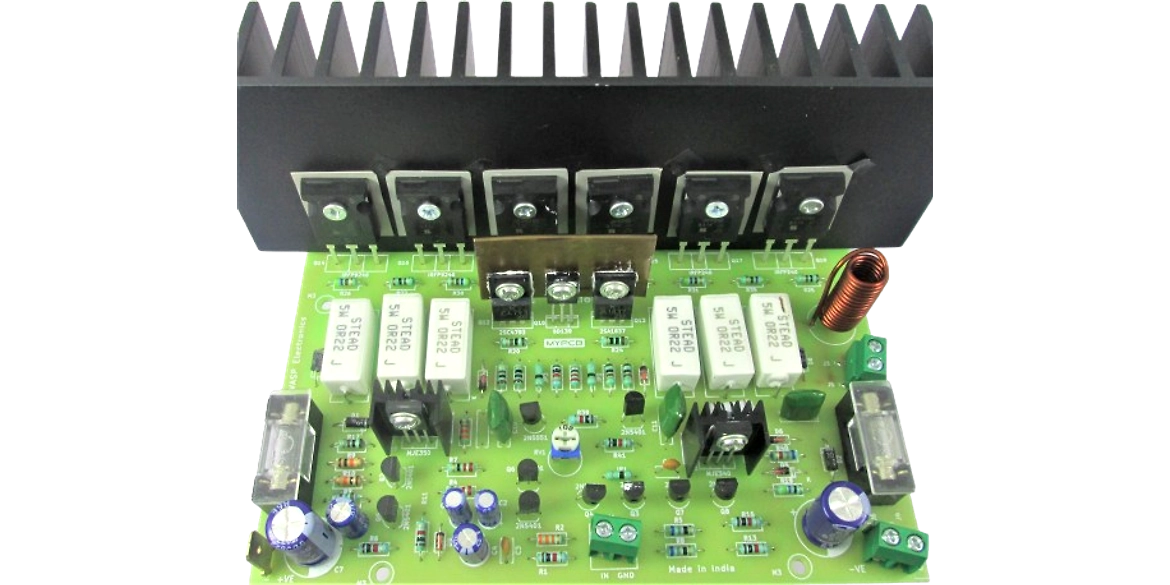Buy PCB's Kits and Components for Audio Amplifiers Pre Amps BT boards Power supplies solar charge controllers Vu Meters & electronics parts at best price
- (+91) 9424930058
- mypcbinfo@gmail.com
- Amphead Electro Works, Aashish Complex, Ward No. 03 NH-46, Itarsi, Itarsi, Madhya Pradesh, India. 461111
© 2020 MYPCB. All Rights Reserved

Intro
High power amplifier for use in DJ's, Public Address systems and other professional applications.
With output short Circuit Protection.
Q10, Q12, Q13 Must be Fitted together on a Heatsink / piece of Aluminum.
Only experienced / advanced users should make this one.
Features of 600 watt mosfet amplifier
- High Output Power - 600 watt Max Dynamic Output Power.
- Low THD +N - 0.1% Total Harmonic Distortion at 400 watt power output using 4Ω Speakers and 1K Hz sine wave input.
- Speaker usability - 4 & 8 ohms, 200 watt to 800 watt speakers can be used.
- Broad supply voltage - ±24 volts to ±50 volts DC supply working range.
- Protection devices - fuses are provided on each supply rail for preventing burnout in case of fault.
- Output Short Protection - in case of output short circuit the amplifier will automatically Shut down preventing damage.
- Standard components - All components used are available online or at your local electronics store.
- No SMD components - Only through hole components used, making soldering and replacement hassle free.
Brief description of 600 watt Amplifier Circuit :-
CLICK HERE to download 600 watt Mosfet amplifier circuit diagram
Input Stage
Input stage works as a transconductance amplifier ( voltage in - current out ).
This stage consist of Long Tailed Pair (LTP) made of Q1 & 65, working as differential amplifier.
Input signal received at the base of Q1 is amplified and sent to VAS from collector. Negative feedback (NFB) received at the base of Q6 from output determines overall gain and balance of the amplifier.
Constant Current Source (CCS) is made of 2 transistors Q2 & Q5 to increase the linearity.
Constant current by it is supplied to the LTP and VAS.
Collector currents of LTP transistors is balanced by Current Mirror (CM) made of Q3 & Q4.
In simple words input signal is amplified by the input pair Q1 & Q6 and sent to VAS for further amplification.
Voltage Amplification Stage (VAS)
As the name suggests, all the voltage gain of the amplifier is achieved in VA Stage.
The VA stage is Darlington (Beta Enhanced) which has better performance then single transistor VA stage.
Signal received from input stage at the base of Q8 is amplified via Darlington pair Q8 & Q11. Voltage amplified signal sent to the base of driver transistor Q13 from the Collector of Q11.
Current limiting circuit made of Q7, R16, R19 is added to VAS, it protects Q11 from overloading.
Constant current is supplied to VAS from CCS made of transistor Q7.
Biasing circuit is made of transistor Q10, which works as voltage divider. With preset RV1, Gate Voltages of output MOSFETs can be precisely adjusted.
Important to note that the biasing transistor Q10 must be fitted on the same heatsink along with Driver transistors Q12 & Q13 to ensure thermal tracking and feedback.
In simple words signal received from input stage is amplified by Q8 & Q11. voltage amplified signal is sent to output stage.
Output Stage ( OPS )
This circuit has Class AB output stage, so each half of the signal is amplified by N-Channel and P Channel output Mosfets.
Driver Transistors Q12 & Q13 work as buffers to prevent excessive loading of VAS and provide input to the output MOSFET's Q14, Q16, Q18 and Q15, Q17, Q19 respectively.
Complementary Feedback Topology ( CF ) is used at OPS. CF Stage is more linear due to local NFB and Thermal tracking is possible with driver transistors.
Output Short Circuit Protection - this circuit monitors current flow across Drain resistors and load, in case of output is shorted to ground the excessive current flow through the resistors will cause the Q20, Q21 to turn on and take away the signal from the driver transistors.
it is advised not to use 2Ω Speakers with this amp.
Zobel Network - made of R338 & C9, provides protection against high frequency oscillations.
Inductor L1 is used to reduce harm from Capacitive load of Speakers Cables.
In simple words signal received from VAS is given to the output MOSFETs via driver transistors. Output MOSFETs conduct high current to drive the speakers load.
Amplifier Type & configuration
- 3 Stage Class AB amplifier
- INPUT - Long tailed pair with Constant current source and current mirror.
- VAS - Darlington VAS with biasing control preset.
- OPS - Complementary Feedback N Channel P Channel MOSFETS.
Input and Gain
- Input Signal Sensitivity - 500mV to 3V ( Peak to Peak)
- Gain - 27.2 dB ±0.1 dB 20Hz - 20KHz ( Fig.1 )
- AC Stability - 750 KHz ( Fig 1 )
- Noise at Output - 86.6 nV/Hz1/2 ( Fig 3 )
Maximum Dynamic Power Output ( Fig 2 )
Output power at various supply voltages -
- ± 24v = 120 Watt
- ±35v = 250 Watt
- ±45v = 400 Watt
- ±50v = 600 Watt
Standard Test configuration for output power measurement -
- IRFP240 IRFP9240 Power MOSFETs.
- 1Khz Sine wave input signal.
- 4Ω 800 watt load resistors
PCB Specification -
- Type of PCB - Single sided, Glass Epoxy FR-4 Grade A
- PCB size - 146 mm x 96 mm, pcb Thickness - 1.6 mm.
- Thickness of copper on PCB - 35 micrometer
PCB designed with thick copper tracks & large solder pads to facilitate straightforward placement and soldering of components.



